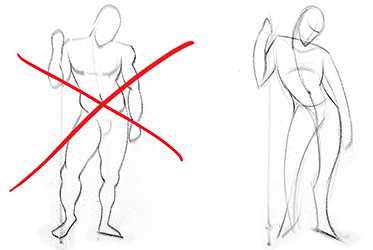Hi and welcome to your drawing journey :) it's a skill that can bring a lifetime of joy!
I also prefer to use pen for most sketching (blue bic specifically). Using a pen will increase your confidence as you practice, so you will start making nice clean lines instead of staggered "hairy" lines. Practice "markmaking" with your pen: make two dots on a page some distance apart, and then try to connect them with one clean line. Use your whole arm, not just your wrist, to get long confident lines. "Ghost" your lines before you commit to them, practice the movement 2-3 times and then put pen to paper. This might seem silly, but all drawings depend on the power of your line, so practice seeing how light of a line you can make (these are good for construction lines) and then adjust your pressure and see how dark of a line you can make (good for fine contours, line art). I'm working on this right now to improve my cross-hatching!
30s sketches: often these sketches consist of a line of action and maybe a few blobs for a head and ribcage. I wouldn't worry about adding features or details in these sketches. The goal is to start warming you up, making it easier to see the underlying forms in your subject, and improve your accuracy in constucting the basic proportions. If you don't get the basic forms correct, it doesn't matter how beautifully you add the details, the overall form willl not read correctly.
As far as your longer sketches, I am basically repeating what I said previously. You're focusing on the contour lines of your subjects, the hard edges. Start constructing your drawing with guidelines with the major bodyparts, like ribcages and heads. Lay down light construction lines, step back for a second and see if it's reading correctly. If not, adjust with another light line. There is so much thinking going on when we are drawing, and if you allow yourself to do a bit of it on the paper rather than in your head, you'll have a much easier time nailing down the overall form.
You're probably already looking at other artists and professionals works, but if not start looking at artists that inspire you and see how they sketch. I included a Stan Prokopenko sketch as an example of a quick gesture drawing (the name of the file is "detail is nothing without gesture").
A link to his site: https://www.proko.com/how-to-draw-gesture/#.XJJdDLhOmrw

 1February 20, 2019 9:09pm #3597I recognize some of those faces :) the brush pen looks neat, harder to get delicate details but I like the brushy sketch look.1
1February 20, 2019 9:09pm #3597I recognize some of those faces :) the brush pen looks neat, harder to get delicate details but I like the brushy sketch look.1




